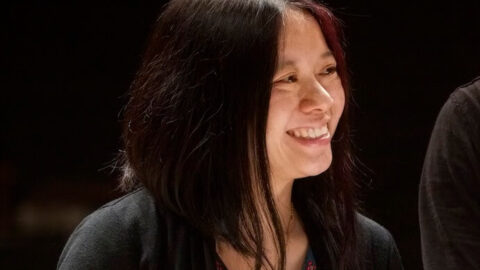Composer and professor of composition (University of Huddersfield; University of Sydney) Liza Lim has written four operas among numerous chamber and orchestral works; these works explore questions that include (but are certainly not limited to): “Australian Indigenous and Asian aesthetics and ritual; a Sufi poetics of bewilderment, communion and ecstasy; weaving & knot-making as a cross-modal ‘technology for thinking’; ecology, temporal slippage, and the uncanny.” Her fourth opera Tree of Codes will receive its US premiere at the Spoleto Festival at the end of May. The opera, which is based on the Jonathan Safran Foer work of the same name, probes questions of time and reality in its experimental approach to narrative, language, and artistic form and boundaries.
Can you talk a little bit about the trajectory of your engagement with the form/genre of opera?
I’ve written four operas: The Oresteia (1993) a ‘memory theatre’ based on Aeschylus’ trilogy; Moon Spirit Feasting (2000), a Chinese ritual street opera; The Navigator (2008) and Tree of Codes (2016). So, that’s a rhythm of one opera every 7 or 8 years, each exploring quite different subjects from Greek tragedy to Chinese myth, aspects of the Tristan and Isolde story and lastly the Eastern European ‘magic realist’ world of Bruno Schultz. Within these diverse sources, I look for ways in which opera can be a ritual space for transformation. I’m interested in a theatre of possession, where the embodiment of music in performance can be a medium for channelling memories, dreams and projections. One of the things I really love about opera as a multiply mediated art form is its capacity to be a theatre of sensations, of sensory abundance and affect and through that, to point to experiments of being and feeling beyond the ordinary.

You’ve stated that Tree of Codes is about “bloodlines and memory” — I’m wondering what your thoughts are on concepts of “inheritance” re: musical traditions & authenticity?
That’s a hard question…The idea about ‘inheritance’ in Tree of Codes is that there are stories and ‘ways of being’ that come from the past, from our ancestors that bubble up almost unconsciously – do we choose our thoughts, beliefs and actions in the present or are these things somehow chosen for us by the past which we then alter as we re-enact them as our own – what resonates in us and where does that come from? That seems fairly mysterious to me and not at all linear. Maybe that’s why I don’t believe in ‘purity’ when it comes to traditions – everything seems on the move to me, ripe for transformation and for remaking as it passes through the next person, the next time.
Please tell us about the Jonathan Safran Foer book/sculptural object this opera is based on, and about the musical/dramatic engagements with this literary work.
Jonathan Safran Foer’s book ‘Tree of Codes’ is made by literally cutting out words and lines of text from the stories of Bruno Schultz’s Street of Crocodiles (1934) in order to create a new story. In Foer’s book this filtering process creates a physical/sculptural patchwork of text floating next to deleted spaces through which one can see other, half-hidden stories. Every page opens up into various poetic spaces through the many associations one makes between different constellations of words and through which subconscious meanings arise.

I’m curious about the temporality(ies?) of Tree of Codes, and your technique involving “cut-outs.”
My idea was to also make a work in which there are holes in the world, perforations in the ordinary through which one might encounter other realities. The opera is set in a world of mutations and blurred boundaries between beings and objects that is reflected in a sonic world of timbral flux. The opera is set in a notional ‘last day of life’ or really in the cracks of time (‘cut-outs in time’) that can appear to us whenever we shift our attention, shift our perception for a moment. In those spaces when ordinary time becomes extraordinary, we can recapture memories, see the past or the future, make new connections between aspects of ourselves. The opera is inhabited by a world of shape-shifting humans, animals and objects that show us this heightened experience – the radiance of life – ordinary life – in the face of death.
What can listeners expect as far as the sound world of this opera?
Musically, I weave together fragments of ‘real life’ found in field recordings (birds, motorbikes revving etc) together with the artifice of lyrical song and weird versions of narrative forms like ballads, a lullaby, funeral music and so on. An example of the power of sound to cross boundaries of perception and communication can be found in the use of bird-calls in the opera. The opera begins with field recordings of Australian birds – the bell miner (Manorina melanophrys) and warbling magpies which really evoke the Australian bush. These are sounds that are really embedded in the emotional consciousness of place and so here the sounds act as triggers for the emotional time and space of childhood. These sounds are then taken up by singers and musicians to create other kinds of musical gestures.
As I said, I’m really interested in opera as a medium for heightened experience – I think of singing – this whole body experience encompassing the total body-vocal mechanism that ranges from guttural sounds, breaths and pants to the purest resonant tones – as such a powerful communicative vehicle for taking one into special emotional states.
Video excerpt of 1st production of ‘Tree of Codes’, Opera Cologne, Ensemble Musikfabrik & Theatre Numero23Prod, conductor: Clement Power, director: Massimo Furlan, Staatenhaus Cologne April 2016.
























